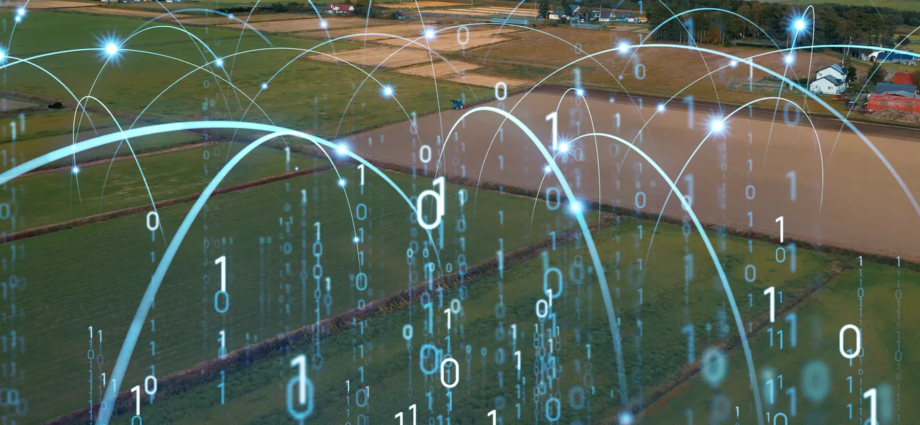
Blockchain could play an important role in future agriculture and food security
Technological advances can help manage more efficient, sustainable and accountable farming practices. (Shutterstock)
Abdul-Rahim Abdulai, University of Guelph; Carling Bieg, University of Guelph; Evan Fraser, University of Guelph, and Sarah Marquis, L’Université d’Ottawa/University of Ottawa
April 11, 2021
Global food supply chains proved brittle during the COVID-19 pandemic, leading for calls to boost the resilience of global food supply chains through improved efficiency in production, distribution and consumption of nutritious food. How could technologies like blockchain that provide data to producers, distributors and consumers be part of the solution?
Big data applications may present opportunities to address inefficiencies from farm to table and improve global food security.
Blockchain, a linked decentralized database that stores auditable data throughout entire supply chains, may change the game for food producers across the globe.
With global-scale food systems such as seafood, nearly 40 per cent of which is traded globally, data transparency and traceability through technologies like blockchain are important for socially and environmentally conscious decision making and to facilitate trust among stakeholders.

Gathering information
Blockchain technologies can be used to consolidate information on the quality of the seed, track how crops grow and record the journey once it leaves the farm. In Canada, for example, Grain Discovery – an online blockchain marketplace – is an example of data being leveraged by those involved in the food system to grow and market globally competitive crops.
The data could enhance transparency in supply chains by providing immutable records from production to consumption. Such data have the potential to facilitate information transfer throughout every step of the supply chain. And if blockchains are implemented with proper validation, it can prevent illegal and unethical production and distribution that undermines sustainability and community food security.
For example, Wal-Mart, Tsinghua University and IBM’s chain-based food traceability platforms have aided in tracing pork and mango in China and U.S. respectively, with positive results in creating trust and transparency in the supply chains.
This transparency also means consumers could make informed decisions to protect vulnerable producers and the environment. Access to product data may allow consumers to reward producers who employ good practices, such as rural smallholder farmers and fishermen who are among the most food-insecure groups.
Tracking pathways
Currently, there is little evidence supporting the claim that blockchain and big data technologies are contributing to global food security. Even though the average farm is projected to generate 4.1 million data points by 2050, up from 190,000 data points in 2014, increases in global food security have not been impressive.
Part of the challenge is how blockchains have been implemented until now. The corporate control of blockchains and big data platforms could even undermine food security.
For example, IBM and Walmart have teamed up to track produce from farm to fork. Producers and processors along the supply chain are required to input information into IBM’s blockchain for the process to be entirely transparent to consumers.
However, there is skepticism around IBM’s definition of blockchain, as privately owned blockchains can be tampered with more easily and are less secure. This is because security of private blockchains are still highly dependent on permissions and controls set by private organizations.
Corporate-owned, centralized databases of information do not meet the traditional definition of a blockchain, which is based on democracy and trust.
Traditional blockchains are decentralized and democratized in order to ensure trust between users. Corporate control of supply chain information could also leave out small-scale farmers that lack the required size, scale and technological know-how to participate. This division between large and small food producers can contribute to global food insecurity, and many researchers believe that small, as well as large farms, are required to feed the world’s growing population.
Data and food futures
Before blockchain and other data technologies can help address food security, a number of challenges need to be addressed.
The implementation of blockchains must be be decentralized to include small farmers and rural people. This will enable sustainable and equitable food systems and allow consumers to make informed decisions.
However, as blockchains place additional responsibility on the end users, challenges such as limited digital literacy among the world’s poor and infrastructure constraints may undermine true decentralization.
Also, they must be integrated into broader food security promotion strategies to make them sensitive to social and environmental values critical to tackling food insecurity among diverse groups.
The untapped potential of harnessing big data through a transparent and decentralized food distribution system may support sustainable food production and provide accountability for food production.
This is crucial for efficient food systems and food security in the future. But it is important that these innovations are deployed equitably so that all stakeholders along the value chain may benefit.
Abdul-Rahim Abdulai, PHD Student, Geography, Environment and Geomatics/Arrell Food Institute, University of Guelph; Carling Bieg, PhD Candidate, Department of Integrative Biology, University of Guelph; Evan Fraser, Director of the Arrell Food Institute and Professor in the Dept. of Geography, Environment and Geomatics, University of Guelph, and Sarah Marquis, PhD Student, Environmental Sustainability, L’Université d’Ottawa/University of Ottawa
This article is republished from The Conversation under a Creative Commons license. Read the original article.


